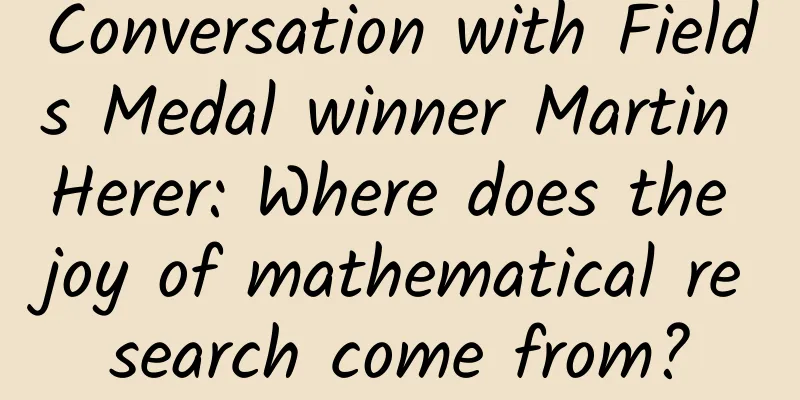Conversation with Fields Medal winner Martin Herer: Where does the joy of mathematical research come from?

|
Fields Medalist Martin Herrell discusses his life, work, and the advice he would give to his younger self. By Beatrice Taylor (PhD student, Department of Computer Science, University College London), Jakob Stein (Postdoctoral Researcher, Mathematics, University College London) Translation | Xu Zhaoqing It was a warm summer afternoon in early July, and we were each sitting in front of our laptops at home, waiting to interview Martin Hairer. We were all a little nervous, because Martin is a well-known expert in the field of stochastic analysis and arguably one of the top scholars in the field of mathematics. A notification popped up on the screen, and Martin was online. He greeted us friendly, and then his politeness and cheerful demeanor put us at ease. Martin was talking to us remotely from a garden hotel in Helsinki; he was attending the International Congress of Mathematicians (ICM) in Finland. The list of the 2022 Fields Medal winners will be announced here soon. The International Congress of Mathematicians is held every four years and awards the Fields Medal, Abacus Medal, Carl Friedrich Gauss Prize and Chern Medal Award. The congress was originally scheduled to be held in St. Petersburg, but due to the conflict between Russia and Ukraine, a series of subsidiary meetings were changed to other countries. Martin served as the chair of the program committee and the coordinator of the parallel sessions for this congress. His duties were to invite experts for the congress presentations and to help guide the conference's transition to parallel parallel sessions. This is not Martin's first time attending the ICM congress - he won the Fields Medal at the 2014 conference for his work on the regularity theory of stochastic partial differential equations. Martin HerrellPhoto credit: Photo by King Ming Lam The road ahead is long and difficult The Fields Medal is perhaps the most famous of Martin's many achievements, but Martin's first taste of success was developing a popular sound editing software package called Amadeus. It can be used for podcast creation or producing original music. He developed the software as a teenager and won an award for it. At the time, it seemed like a perfect way to practice his newly learned programming skills and satisfy his love of music. "I was mainly into classic pop-rock music, you know, like Pink Floyd, Dire Straits, or the Beatles." Amadeus would go on to become Martin's masterpiece, but it's hard to understand how Martin had the time to do all this: software development should be a full-time job, and he's a Fields Medal-winning mathematician, so it's unusual for him to do all this at the same time. Martin said frankly, "I haven't had a lot of time in the past few years," explaining that recently he only has time to maintain his software, but "no time for development." Given Martin's early success in software development, did he ever consider studying computer science in college? “Yes, I did think about it. I guess the reason I didn’t study computer science as an undergraduate was that I was a little arrogant and thought I had somehow understood that stuff,” Martin said with a shy smile. Martin decided to study physics as an undergraduate and went on to pursue a doctorate in the physics department. For him, this was a deliberate teenage rebellion - Martin's father was a distinguished mathematics professor and had his own list of honors. But perhaps it was not the most effective rebellion. Martin admitted that during his undergraduate years, he still took a lot of math courses. In addition, he said that his doctorate could also be obtained in the mathematics department of most universities. It was interesting and comforting to hear a distinguished scholar talk about job insecurity, as it is a concern for many PhD students and a reality that many postdoctoral researchers have to deal with. Despite these concerns, Martin chose to continue working in academia at the time, eventually transferring to the Department of Mathematics for postdoctoral research. Martin likes academic work very much. For him, this job provides one of the best things about being a mathematician: "At least to a certain extent, I can basically do what I want to do freely." Martin continued: "In a sense, an academic does not really have a boss. I mean, in a university institution, officially you always have a department head or someone like that, but they don't tell you what to do. So you can do what you want to do to a large extent, and I think this freedom is extremely valuable." Every little thing For a mathematician with a staggeringly long list of awards, Martin was generous with his time and approachable, happy to discuss any topic we threw at him. The only thing he was a little shy about talking about was the award itself. We asked him what his greatest achievement was, or what award he was most proud of, and expected him to mention the Fields Medal, or the Breakthrough Prize he won in 2021. But he replied that nothing was more important than solving his regularity theory. The term “the joy of problem-solving” came up several times during our conversation. Where does this joy come from? Is it the feeling of knowing that a theory is complete, or knowing that a difficult problem has been solved and that the frown is no longer on your face, or knowing that the work will be published? For Martin, the joy lies in that initial phase, when everything starts to click. "There are a few days where you're scribbling like crazy, trying to convince yourself that this could actually work. Relatively quickly, I convinced myself that it was possible and that it was important in some way. Obviously, I needed a lot more time to work out the kinks, but I knew it was possible, so that last part didn't take too long." Martin's work focuses on understanding small-scale randomness through the large-scale behavior of systems, especially stochastic partial differential equations (SPDEs), which are a class of partial differential equations in which some of the parameters are random variables or the solutions to the equations can be expressed in terms of random variables. One of the most famous stochastic partial differential equations Martin studied is the Kardar-Parisi-Zhang equation. Imagine a piece of paper that is ignited from the bottom edge. If you stand far away, you will see the top edge of the charred part move upward in an almost predictable way; but if you stand close, the burning part looks messy and jagged. The KPZ equation describes this situation: if we use h(x, t) to represent the height of the charred part at time t, then the equation for the burn height is as follows, Here, λ and ν are constants that indicate how flammable the paper is. The important term in this equation is η(x, t), which is a random "white noise". If we ignore this term, we get a partial differential equation (PDE). This PDE is still tricky, but it is solvable, and the solutions have many interesting properties. For example, the PDE has a smooth solution. However, the presence of white noise complicates the problem. For decades, most mathematicians had no idea how to analyze the function h(x, t). Martin found a way to make the equation make sense. The solution can be summarized as "subtracting infinity from infinity." Translator's note: Here, infinity minus infinity refers to a renormalization technique. For example, two divergent terms that grow logarithmically cancel each other out during the approximation process and obtain a finite term. Interested readers can refer to Martin Herrell's work on the KPZ equation in Annals of Mathematics in 2013. Martin's regularity theory for stochastic partial differential equations shocked the mathematical world - his ideas seemed unexpected. One reason the regularity theory shocked the mathematical world was that the breakthrough idea came from physics - using finite series of wavelets (commonly used to encode information in digital files) to understand the behavior of stochastic partial differential equations. Martin's research continues to focus on random processes. One of his current projects explores discrete systems that evolve according to simple rules. "You try to understand the global, large-scale behavior of these things, and the limits that you get in this way. There are certain restrictions on how dynamical systems are understood, and there are other cases where the problem is completely unsolved. There is a lot of work to be done in this area - it will be the arena of probability theory. The first result of this kind of problem should be the central limit theorem... It goes back to the 18th century." Describing the development trend of mathematics, Martin said, "People have always been interested in these areas. There are periods of stagnation in history, and there are also periods when people come up with new techniques and flourish because of it. This is the way mathematics develops." A unique mathematician wearing colorful socks Photographed by King Ming Lam my life For the past five years, Martin has been a professor at Imperial College London, where he is a researcher, PhD supervisor and often speaks about his cutting-edge work at master's courses. Martin regularly runs summer schools for PhD students and budding researchers. For Martin, as a researcher, teaching courses at summer schools is very important because sharing knowledge is fundamental to the advancement of mathematical ideas. "If you just do your own thing alone in a corner and don't explain it to anyone, there's not much point, right?" Two years of the COVID-19 pandemic have changed the way mathematics is taught, developed and discussed. After these changes, Martin is happy to return to offline events. "In the beginning, people were very enthusiastic about online seminars and workshops. They work very well. You can even use iPads to write on the blackboard and give lectures." But, he added, "this method quickly fell out of fashion." A new hybrid way of working does have advantages: it makes it easier to collaborate with researchers in foreign countries, easier to attend conferences remotely, and more convenient for those who may need to take care of children or have difficulty getting to the office for physical reasons. However, for many of us, the joy of doing mathematics lies in working with others, and it is difficult to achieve a smooth exchange of ideas face to face online. "Online participation can only communicate with people and understand what is going on in the mathematical community; but you can't really understand the content of the conference just by listening." How will the COVID-19 pandemic affect the future of mathematics? Martin said, "We seem to be moving towards a new model where speakers can choose to speak remotely or participate in person." This approach seems to be a good balance between social interaction and convenience. Hailer with Artur Avila, Manjul Bhargava and Maryam Mirzakhani in 2014. Image source: Wikimedia Commons Working together In 2014, Haier won the Fields Medal along with Artur Avila, Manjul Bhargava, and Maryam Mirzakhani. Avila was the first South American mathematician to win the Fields Medal; Bhargava was the first Indian-born mathematician to win the award; and Mirzakhani was the first woman to win the award. These awards came 78 years after the Fields Medal was created. After our interview, the 2022 winners were announced: Hugo Duminil-Copin, June Huh, James Maynard, and Maryna Viazovska, the second woman to win the award. Science, technology, engineering and mathematics (STEM), especially math, has a persistent problem with lack of diversity. Does Martin think the International Congress of Mathematicians has a responsibility to do more to increase representation of different genders and minorities in science? Martin has insights on this. "It's a tricky issue," he said, especially when science transcends gender and is not well represented in terms of race, socioeconomic status and cultural background. "It's like a leaky pipeline, with fewer and fewer women over time. It's hard to find a solution; and the last thing you want to do with an award like the Fields Medal is to set some kind of quota because that just reduces its value." "So the right thing to do is to let it develop slowly, and there will be more diversity in the future." Martin is hopeful about the increasing representation of women in mathematics. "You can see that in this ICM conference, the proportion of female speakers is about 25%, and in the last one, it was about 15%." Waiting for this to happen will only work if we have special structures in place to support minorities and allow them to flow into all fields without hindrance. This is a difficult task - it is important that we encourage people from a young age to study mathematics and to believe that studying mathematics is a viable career, regardless of their background. “Maybe I should have paid more attention in my algebra class.” More importantly, Martin goes on to advise students just starting their undergraduate studies: “Follow your gut and do what you find interesting.” In conversation with Martin Hairer, Chalkdust Issue 16 Original article address: https://chalkdustmagazine.com/interviews/in-conversation-with-martin-hairer/ Produced by: Science Popularization China |
>>: “Not even recognizing one’s own mother”, this is possible!
Recommend
Xiaomi's mobile phone product marketing director confirmed that it will enter the Japanese smartphone market in 2020
Recently, Japanese media revealed that Xiaomi wil...
Why is the plan written so comprehensively but useless?
Understand the general product situation step by ...
IPv6 addresses are running out, and operators are launching IPv6 pilot projects
As the global IPv4 addresses are about to run out...
How much does it cost to make a paper product mini program in Huzhou?
How much does it cost to join a paper product min...
Can tiny moss help realize “interstellar migration”?
Produced by: Science Popularization China Author:...
Chinese jailbreakers, start running tonight
iOS 9 is officially released Tonight, hundreds of...
How much does it cost to join the Hengshui Electric Mini Program? What is the price for joining Hengshui Electric Mini Program?
How much does it cost to join an electrical mini ...
How to choose between iPhone and Android? Compare their 6 major advantages and choose the most suitable phone
You've probably all been torn between the iPh...
Wall Street Academy "Analysis of the Key Points of Investment Research and Analysis Practice" Investment Research and Analysis Practical Skills [MP4/PDF/1.17GB]
"Wall Street Academy's "Analysis of...
How much does it cost to produce the Tianshui Printing mini program?
In order to better penetrate into various industr...
"Chinese medicine store prepared sour plum soup" is popular, but 4 types of people are not suitable for drinking it
According to media reports, recently, videos of C...
Pinduoduo’s strategic techniques for user growth!
In the war among many e-commerce giants, Pinduodu...
Classic SEO case, classic SEO case for fast ranking of old website!
I believe everyone is familiar with quick ranking...
Tips and strategies for becoming a “super user”!
The free feast on the Internet is becoming a thin...
Android Framework Problem Analysis Case - Who Killed the Desktop?
The opportunity to write this article is due to a...









